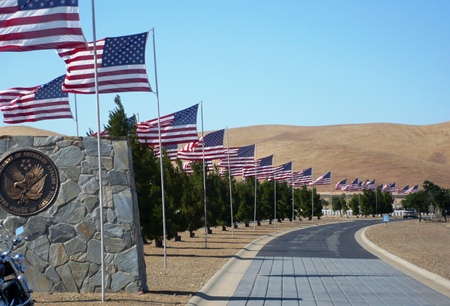National Cemetery Administration
San Joaquin Valley National Cemetery

Visitation Hours: Open daily from 8:00 a.m. to 5:00 p.m.
Office Hours: Monday thru Friday 7:30 a.m. to 4:00 p.m. Closed federal holidays except Memorial Day.
This cemetery has space available to accommodate casketed and cremated remains.
Burial in a national cemetery is open to all members of the armed forces who have met a minimum active duty service requirement and were discharged under conditions other than dishonorable.
A Veteran's spouse, widow or widower, minor dependent children, and under certain conditions, unmarried adult children with disabilities may also be eligible for burial. Eligible spouses and children may be buried even if they predecease the Veteran.
Members of the reserve components of the armed forces who die while on active duty or who die while on training duty, or were eligible for retired pay, may also be eligible for burial.
From San Jose Airport, drive south on 101 then East on State Route 152 (toward Los Banos). As you drive over Pacheco Pass go left on State Highway 33. Drive about three and a half miles on Highway 33 then turn left on McCabe Road. Travel four miles. The cemetery will be at the end of the road.
Fax all discharge documentation to the National Cemetery Scheduling Office at 1-866-900-6417 and follow-up with a phone call to 1-800-535-1117.
For information on scheduled burials in our national cemeteries, please go to the Daily Burial Schedule.
Military Funeral Honors
There are several organizations, both military and service organizations, that provide a funeral honors detail for services. Those providing the honors details are primarily VFW groups, as well as American Legion, Lemoore Naval details (two days) and the California State National Guard from Fresno, CA. You can also request military funeral honors through your funeral home from the Department of Defense.
For educational materials and additional information on this cemetery, please visit the Education section, located below.
Fresh and artificial floral displays may be placed on the graves at any time. Floral containers are available throughout the cemetery.
Floral displays will be removed when they become faded and unsightly or as necessary to facilitate cemetery operations. All items will be removed on the first and third Wednesday of every month. The pick up schedule is posted at the traffic circle at the end of Tres Cerritos Boulevard. (NO FLORAL PICKUPS IN DECEMBER.)
Plantings are not permitted on the graves at any time.
To maintain the dignity of the cemetery, commemorative items, balloons, pinwheels, glass or breakable items, votive lights, statues, shepherd's hooks, etc., are not allowed. Cemetery staff will remove non-floral items immediately. Items appearing to be of sentimental or keepsake value will be retained for one month before disposal.
No item or object may be attached to a headstone or marker in a national cemetery.
No candles or open flames (fire hazard).
VA regulations 38 CFR 1.218 prohibit the carrying of firearms (either openly or concealed), explosives or other dangerous or deadly weapons while on VA property, except for official purposes, such as military funeral honors.
Possession of firearms on any property under the charge and control of VA is prohibited. Offenders may be subject to a fine, removal from the premises, or arrest.
The creation of San Joaquin Valley National Cemetery is the sixth in the state and 114th in the National Cemetery Administration.
The Romero Ranch Company donated the land for the cemetery to the Department of Veterans Affairs on February 3, 1989. Construction of the 105-acre first phase began July 15, 1990. The water-pumping station on the California Aqueduct, the last element of construction, was completed in May 1992. The first phase yielded about 15,000 gravesites and 8,000 in-ground cremation sites.
Monuments and Memorials
The California Korean War Veterans Memorial was dedicated August 1, 1998. The memorial is a composition of 16 individual granite five-foot monoliths arranged to form a circle. These 16 granite monoliths combined contain the total names of the 2,495 Californians who gave their lives fighting in the Korean War. The memorial was sponsored by a number of veteran service organizations, individuals and corporations.
The 11th Airborne Memorial is a granite and bronze monument that was dedicated on May 11, 2002, in honor of all airborne soldiers. The sculptor was William Porteus, a member of the 511th unit.
Medal of Honor
The Medal of Honor is the highest award for valor in action against an enemy force that can be bestowed upon an individual serving in the Armed Services of the United States. Recipients receive the Medal of Honor from the President on behalf of Congress. It was first awarded during the Civil War and the eligibility criteria, medal design, and recognition on a recipients' grave marker have all evolved over time. There are 390 Medal of Honor recipients interred in VA national cemeteries.
» Medal of Honor recipients buried or memorialized here:
Seaman William Troy (1871 Korean Campaign). He received the Medal of Honor while serving in the U.S. Navy for actions on board the USS Colorado during the capture of the Korean forts, June 11, 1871. Troy died in 1907 and is memorialized in Section M-1, Site 53.
We are developing educational content for this national cemetery, and will post new materials as they become available. Visit the Veterans Legacy Program and NCA History Program for additional information. Thank you for your interest.


















